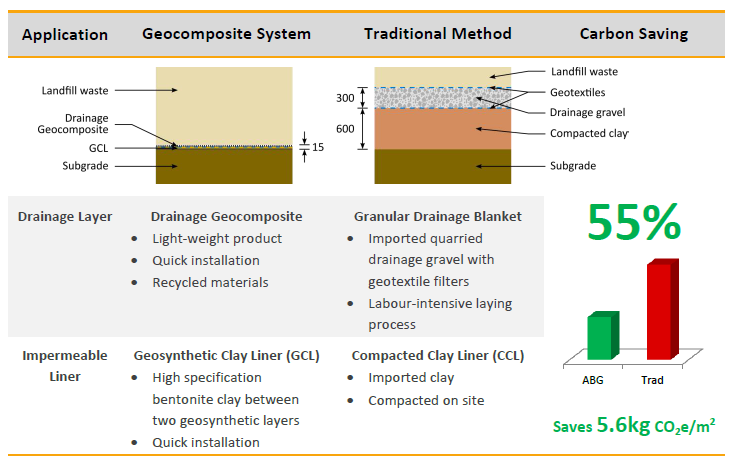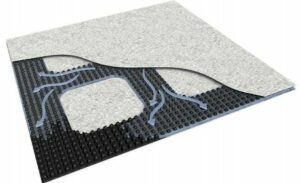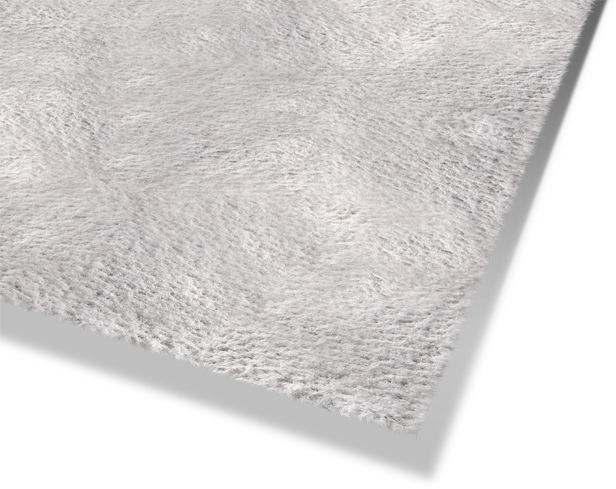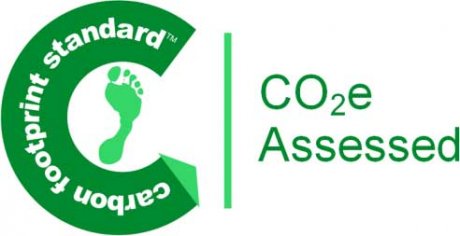
The traditional method is based on a granular drainage blanket with filter geotextiles above and below to prevent fine material from clogging the drainage blanket. The geocomposite system is a drainage geocomposite (Pozidrain G6SD/NW8) over a GCL (Claymat AS4500). Pozidrain G6SD/NW8 consists of a cuspated HDPE core with filter textiles either side. Claymat AS4500 is made up of a filter geotextile, 4.5kg/m2 bentonite, and a woven geotextile. The total thickness of the geocomposite system is just under 15mm which provides the added benefit of increasing the available volume of the landfill.

Pozidrain G6SD/NW8

Claymat AS4500
General Assumptions
The analysis method follows that described in the WRAP report (Corney, 2010). The carbon associated with four key stages is assessed a) removal and disposal of waste soil, b) the embodied carbon of imported materials, c) the transportation of imported materials to site, and d) construction on site. In this analysis the removal of waste material has been ignored. The assessment of embodied carbon is discussed below for each analysis.
The transportation of imported materials is generally based on the installation site being 200 miles from ABG (or equivalent geosynthetics supplier) and 10 miles from the nearest quarry. Fuel economy is estimated as 4.4 miles/L for light ABG delivery wagons, and 2.2 miles/L for bulk aggregate transport. The weight of material transported per load varies for each item. The carbon footprint of burning diesel is assessed as 2.60 kgCO2e/L (kilograms of carbon dioxide equivalent per litre of fuel) based on the value given for ‘Diesel (average biofuel blend)’ in the DEFRA report (Department for Environment Food & Rural Affairs, 2018).
The carbon footprint from emissions during construction is typically based on previous studies (Athanassopoulos & Vamos, 2011) and engineering judgement from ABG experience, assuming the fuel efficiency of the vehicles used is 25 L/hr (see below for further details).
Drainage Layer
The embodied carbon of the drainage gravel is assumed to be quarried crushed rock with an embodied carbon footprint of 0.0052 kgECO2e/kg as per the ICE report (Hammond and Jones, 2011). The embodied carbon of all filter textiles and ABG Pozidrain G6SD/NW8 is based on ABG internal assessments (Heritage, 2020) and ‘Obtaining reliable embodied carbon values for geosynthetics’ (Raja, 2015). The installation time is based on previous studies (Athanassopoulos & Vamos, 2011) and engineering judgement from ABG experience.
Impermeable Liner
The embodied carbon of both the CCL and GCL, and the installation time of both components, is based on the work of Athanassopoulos & Vamos (Athanassopoulos & Vamos, 2011). The transportation of the GCL to site is based on delivery to site in the UK direct from the manufacturing plant in Poland – an estimated distance of 1,200 miles. The clay is assumed to be from a source 10 miles from site.
Carbon Standard
The Carbon Footprint Standard logo shown below demonstrates that ABG’s carbon footprint assessments have been verified by Carbon Footprint Ltd. This verification covers both the company footprint in accordance with ISO 14064-3 (Fernandez, 2020a), as well the footprint of all ABG’s products (Fernandez, 2020b).
References
Athanassopoulos, C., & Vamos, R. (2011) Carbon footprint comparison of GCLs and Compacted Clay Liners. In Geo-Frontiers 2011. Dallas
Corney, N. et. al. (2010) Sustainable Geosystems in civil engineering applications, WRAP Geosystems Report MRF116-001
Department for Environment Food & Rural Affairs (2018). UK Government GHG Conversion Factors for Company Reporting
Fernandez, J. (2020a) Carbon Footprint Verification Report for ABG Geosynthetics Ltd, Carbon Footprint Ltd.
Fernandez, J. (2020b) Product Footprint Methodology Verification for ABG, Carbon Footprint Ltd.
Hammond, G. & Jones, C. (2011) Inventory of Carbon & Energy (ICE) Version 2.0, Sustainable Energy Research Team (SERT) Department of Mechanical Engineering, University of Bath, UK
Heritage, R. (2020) Assessed Carbon Footprint of ABG Products, ABG Geosynthetics Ltd [Accessed 4th May 2020]
Raja, J., Dixon, N., Fowmes, G., Frost, M. and Assinder, P. (2015). Obtaining reliable embodied carbon values for geosynthetics. Geosynthetics International. [http://dx.doi.org/10.1680/gein.15.00020]



